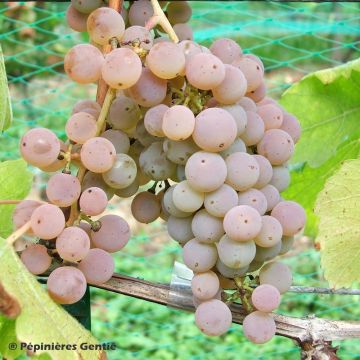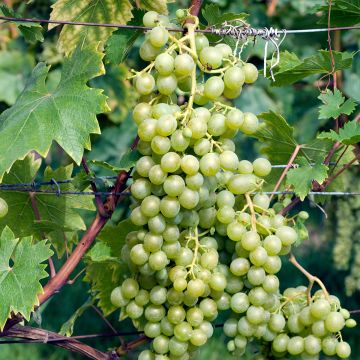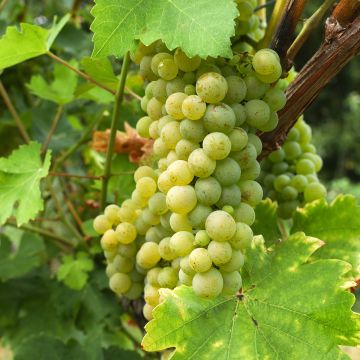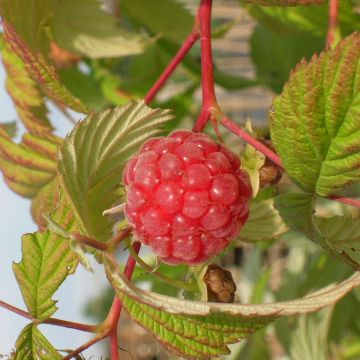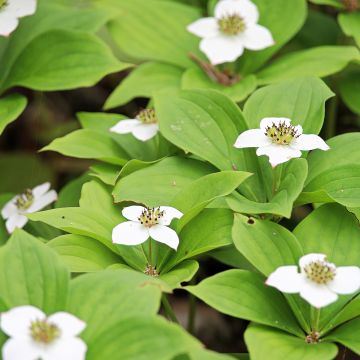

Vigne sans pépin Aperina rossa
Vitis vinifera Aperina rossa - Seedless Grape vine
Vitis vinifera Apirena Rossa
Common Grape Vine, European Grape, Wine Grape
This item cannot be shipped to the selected country
Oversize package delivery charge from €6.90
Delivery to Corse prohibited
More information
Schedule delivery date,
and select date in basket
This plant carries a 6 months recovery warranty
More information
We guarantee the quality of our plants for a full growing cycle, and will replace at our expense any plant that fails to recover under normal climatic and planting conditions.
Oversize package: home delivery by special carrier from €6.90 per order..
Express home delivery from €8.90.
Delivery to Corse prohibited: UE law prohibits the import of this plant from mainland France to Corse as part of the fight against Xylella fastidiosa. Please accept our sincere apologies.
More information
Does this plant fit my garden?
Set up your Plantfit profile →
Description
This 'Aperina Rosso' vine is another interesting descendant from the Sultanine (also known as Thompson Seedless), a variety known as "seedless", cultivated on a large scale for the production of raisins. They all have the common characteristic of producing apyrene grapes, with atrophied seeds. Very pleasant to taste, they will delight children! This Rosso variety is similar to Cardinal in terms of flavor and berry color. The plant is vigorous, moderately resistant to diseases, and not well suited to cold climates. It produces beautiful clusters of round fruits, medium-sized, with dark red-violet skin, and the flesh is juicy, sweet, and neutral in flavor. The harvest takes place, depending on the region, year, and climate, from mid-September onwards.
'Aperina Rosso' belongs, like all vines, to the Vitaceae family. Its first parent, the Sultanine vine, is itself a very ancient hybrid, possibly originating from Afghanistan, which belongs to the category of white table grape varieties. Sultanine is a vigorous plant that needs to be pruned long in late winter because its first buds do not produce flowers. It passed on this characteristic to all its apyrene descendants.
The 'Aperina Rosso' vine is a sarmentous and climbing bush of great vigor, whose serpentine stems equipped with tendrils can exceed 4 to 5 meters (13 to 16 feet) in length over time. It forms a trunk, often knotty and tortuous, covered with fibrous and brown bark that flakes off in strips as it ages. Its long green stems bear beautiful round-shaped leaves, with serrated edges, of medium green color, turning yellow before falling in autumn. It flowers in late spring, from May to June depending on the region, in the form of dense and well-formed clusters, pyramidal in shape, somewhat irregular, loaded with tiny green flowers. After pollination by insects, the berries, which we call grapes, form. Under their skin, which is red-violet in colour when ripe, quite thick and covered with a white bloom, the flesh is tender green, almost devoid of true seeds. Juicy and sweet, it has a fairly simple, not very pronounced flavor. This variety is pruned long in late winter, after the frost, above 6-8 buds, to promote the formation of new shoots that will flower.
Contrary to popular belief, seedless grapes are not genetically modified organisms, but they are the result of a complex selection process carried out by vine specialists. They are fruits borne by sterile hybrid plants, whose seeds, or seeds, are unable to develop: reduced to their simplest expression, these seeds are barely detectable in the mouth.
Planted in the sun, the Aperina Rosso vine will be very decorative along a wall, on an arbor, a pergola, in the ground or in a large container on a terrace. This variety, both delicious and decorative, will be appreciated for garden ornamentation. Its fruits can be consumed as they are, mixed in fruit salads, as juice, or to garnish pies.
Report an error about the product description
Vitis vinifera Aperina rossa - Seedless Grape vine in pictures


Plant habit
Flowering
Foliage
Botanical data
Vitis
vinifera
Apirena Rossa
Vitaceae
Common Grape Vine, European Grape, Wine Grape
Cultivar or hybrid
Other Grapevines
Planting and care
The Aperina Rosso Vine should be planted in a well-drained, preferably clay-limestone soil, even stony, that you have worked well and enriched with organic fertilizer or compost. Once well established, the vine can withstand summer drought, as its roots dive deep to seek moisture. Choose a full sun exposure, possibly partial shade in the south (southeast exposure). It can tolerate temperatures as low as -12/-13°C (10.4/8.6°F) for very short periods and requires long, hot summers to fruit well.
Prune it in February-March, after the frost, leaving 6 or 8 buds on the secondary branches. Prune it again once the grapes have formed on the clusters, leaving 2 or 3 leaves above each cluster (this allows the sun to reach the fruit and the sap to feed them more effectively). Once the structure of your trellis is formed, remove every year the branches that have produced fruit. Stake or train to support and guide the branches. Train it against a wall to directly benefit from the grapes. Downy mildew and powdery mildew are common (especially in rainy climates), which is why the vine should be treated as a precaution in spring and during summer, with Bordeaux mixture and/or sulfur powder. This vine may take a season to establish well, during which it will grow moderately. Its woody climbing stems will then gain several meters per year and will require pruning.
Planting period
Intended location
Care
This item has not been reviewed yet - be the first to leave a review about it.
Berries
Haven't found what you were looking for?
Hardiness is the lowest winter temperature a plant can endure without suffering serious damage or even dying. However, hardiness is affected by location (a sheltered area, such as a patio), protection (winter cover) and soil type (hardiness is improved by well-drained soil).

Photo Sharing Terms & Conditions
In order to encourage gardeners to interact and share their experiences, Promesse de fleurs offers various media enabling content to be uploaded onto its Site - in particular via the ‘Photo sharing’ module.
The User agrees to refrain from:
- Posting any content that is illegal, prejudicial, insulting, racist, inciteful to hatred, revisionist, contrary to public decency, that infringes on privacy or on the privacy rights of third parties, in particular the publicity rights of persons and goods, intellectual property rights, or the right to privacy.
- Submitting content on behalf of a third party;
- Impersonate the identity of a third party and/or publish any personal information about a third party;
In general, the User undertakes to refrain from any unethical behaviour.
All Content (in particular text, comments, files, images, photos, videos, creative works, etc.), which may be subject to property or intellectual property rights, image or other private rights, shall remain the property of the User, subject to the limited rights granted by the terms of the licence granted by Promesse de fleurs as stated below. Users are at liberty to publish or not to publish such Content on the Site, notably via the ‘Photo Sharing’ facility, and accept that this Content shall be made public and freely accessible, notably on the Internet.
Users further acknowledge, undertake to have ,and guarantee that they hold all necessary rights and permissions to publish such material on the Site, in particular with regard to the legislation in force pertaining to any privacy, property, intellectual property, image, or contractual rights, or rights of any other nature. By publishing such Content on the Site, Users acknowledge accepting full liability as publishers of the Content within the meaning of the law, and grant Promesse de fleurs, free of charge, an inclusive, worldwide licence for the said Content for the entire duration of its publication, including all reproduction, representation, up/downloading, displaying, performing, transmission, and storage rights.
Users also grant permission for their name to be linked to the Content and accept that this link may not always be made available.
By engaging in posting material, Users consent to their Content becoming automatically accessible on the Internet, in particular on other sites and/or blogs and/or web pages of the Promesse de fleurs site, including in particular social pages and the Promesse de fleurs catalogue.
Users may secure the removal of entrusted content free of charge by issuing a simple request via our contact form.
The flowering period indicated on our website applies to countries and regions located in USDA zone 8 (France, the United Kingdom, Ireland, the Netherlands, etc.)
It will vary according to where you live:
- In zones 9 to 10 (Italy, Spain, Greece, etc.), flowering will occur about 2 to 4 weeks earlier.
- In zones 6 to 7 (Germany, Poland, Slovenia, and lower mountainous regions), flowering will be delayed by 2 to 3 weeks.
- In zone 5 (Central Europe, Scandinavia), blooming will be delayed by 3 to 5 weeks.
In temperate climates, pruning of spring-flowering shrubs (forsythia, spireas, etc.) should be done just after flowering.
Pruning of summer-flowering shrubs (Indian Lilac, Perovskia, etc.) can be done in winter or spring.
In cold regions as well as with frost-sensitive plants, avoid pruning too early when severe frosts may still occur.
The planting period indicated on our website applies to countries and regions located in USDA zone 8 (France, United Kingdom, Ireland, Netherlands).
It will vary according to where you live:
- In Mediterranean zones (Marseille, Madrid, Milan, etc.), autumn and winter are the best planting periods.
- In continental zones (Strasbourg, Munich, Vienna, etc.), delay planting by 2 to 3 weeks in spring and bring it forward by 2 to 4 weeks in autumn.
- In mountainous regions (the Alps, Pyrenees, Carpathians, etc.), it is best to plant in late spring (May-June) or late summer (August-September).
The harvesting period indicated on our website applies to countries and regions in USDA zone 8 (France, England, Ireland, the Netherlands).
In colder areas (Scandinavia, Poland, Austria...) fruit and vegetable harvests are likely to be delayed by 3-4 weeks.
In warmer areas (Italy, Spain, Greece, etc.), harvesting will probably take place earlier, depending on weather conditions.
The sowing periods indicated on our website apply to countries and regions within USDA Zone 8 (France, UK, Ireland, Netherlands).
In colder areas (Scandinavia, Poland, Austria...), delay any outdoor sowing by 3-4 weeks, or sow under glass.
In warmer climes (Italy, Spain, Greece, etc.), bring outdoor sowing forward by a few weeks.


































